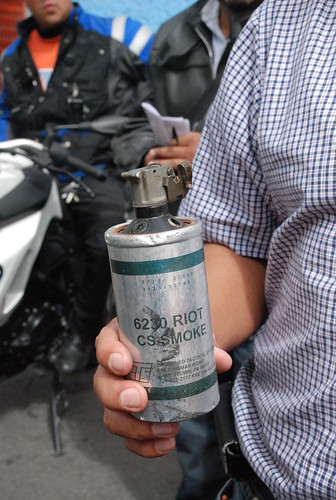 At least two SME actions outside LyFC buildings were violently repressed when Federal Police (PFP) attempted to prevent the SME from hanging its strike banners. However, in both instances the SME and supporters repelled the police and hung their strike banners.
At least two SME actions outside LyFC buildings were violently repressed when Federal Police (PFP) attempted to prevent the SME from hanging its strike banners. However, in both instances the SME and supporters repelled the police and hung their strike banners.  The repression began at Cables Bolivar in central Mexico City. "When we tried to hang our strike banners, the PFP started yelling insults at our compañeros," says Gerardo Avelar, the SME's Secretary of Agreements. "We dialogued with the PFP's commanding officer on site so that we could peacefully hang our banner. He accepted this. However, when the banners were hung, a member of the PFP irresponsibly pulled down a banner that we had hung with [the commanding officer's] permission." The PFP then began to fire tear gas into the crowd, according to Avelar. While the exact number of tear gas canisters fired is unknown, SME members were able to show this reporter pieces from four spent canisters: two rifle-fired canisters and two hand-thrown grenades.
The repression began at Cables Bolivar in central Mexico City. "When we tried to hang our strike banners, the PFP started yelling insults at our compañeros," says Gerardo Avelar, the SME's Secretary of Agreements. "We dialogued with the PFP's commanding officer on site so that we could peacefully hang our banner. He accepted this. However, when the banners were hung, a member of the PFP irresponsibly pulled down a banner that we had hung with [the commanding officer's] permission." The PFP then began to fire tear gas into the crowd, according to Avelar. While the exact number of tear gas canisters fired is unknown, SME members were able to show this reporter pieces from four spent canisters: two rifle-fired canisters and two hand-thrown grenades.The tear gas was manufactured by US-based Combined Tactical Systems, the same company that manufactured the tear gas used in the 2009 Bagua, Peru, massacre of indigenous protestersand the violent attack against striking teachers in Morelos, Mexico in 2008.
When the PFP fired tear gas at the SME, the gas wafted into surrounding schools and homes, affecting the children inside. The Cables Bolivar complex is located across the street from an elementary school and catty-corner to a daycare. The SME reports that 2-month-old Alexis Emiliano Hernández was hospitalized when tear gas entered his home near Cables Bolivar.
Calls to support the SME in Cables Bolivar went out over Twitter and Radio SME, and support quickly arrived from other parts of the city. Students from the Autonomous University of Mexico City, the Urban Movement of Popular Power, and other organizations quickly arrived and drove back the police. Avelar says, "We will not move from here until the Ministry of the Interior or the Supreme Court presents a solution to this problem."
The second confrontation with police occurred in Juandho, Hidalgo. SME members and supporters blocked the entrance to the Juandho LyFC complex with piles of dirt. According to El Universal, "This angered the federal police, leading to a confrontation." The police fired tear gas and pepper spray at the crowd, and fired live rounds into the air. El Universal reports that following the repression, approximately three police helicopters and 400 federal police arrived on the scene to drive back protesters.
Following the police repression, floodgates that guard a canal of raw sewage were opened, flooding the LyFC complex and the police inside. At the time of publication, it has not been confirmed how the floodgates opened. However, the flood seems to have incapacitated the police--reports from Juandho indicate that the SME still holds its blockade of the LyFC complex there.
The SME continues to blockade key LyFC buildings, and will do so indefinitely. The workers have organized themselves into shifts that will maintain the picket lines around the clock. As nighttime fell, a "tense calm" fell over the blockades. Police continue to attempt to penetrate the blockades, particularly in Nexaca, Hidalgo, and there is fear that police will attack in the night while the majority of the region is asleep.
National Support
Actions in support of the SME reportedly occurred in about 25 states.
The national strike has inspired organizations all over the country to take bold measures to support the SME as well as their own causes. Several organizations took advantage of the national strike in support of the SME to pressure the government to cede to their own demands.
Oaxacan teachers, in addition to sending a delegation to the Mexico City protests, blocked government buildings and highways in their own state, bringing transit to a standstill. Their actions were in support of the SME, but also designed to pressure the government in their own 2010 contract negotiations.
Students from the Autonomous University of Mexico City rushed to the SME's aid in front of the Cables Bolivar complex after police attacked there. The city government has cut all funding for their university, leaving them unsure how they will continue their studies. They arrived at Cables Bolivar with signs that said, "Less Military, More Education."
Miners in Cananea, Sonora, blocked a federal highway there. The company that owns the mine where they work refuses to recognize their union and seeks massive layoffs. The government has authorized the military to take over the mine. The miners participated in the SME's national strike by blocking the Cananea-Agua Prieta federal highway and have vowed to remain there until their own labor dispute is resolved. The SME and the Miners Union have a strong relationship and a history of mutual aid.

 Print This
Print This 

 Print This
Print This